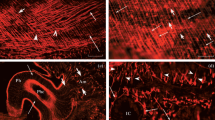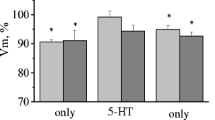Abstract
The study was performed on effects of serotonin and its antagonists (mianserin, propranolol, and metergoline) on efferent electrical activity in nerves cervicalis superior, cervicalis inferior, and columellaris innervating muscles withdrawing body of Lymnaea stagnalis into the shell. Serotonin had a dual effect on the off-reactions caused by rhythmical light stimulation of mollusc skin. The number of responses to series of stimuli increased at serotonin concentrations of about 10−8-10−7 M and decreased at its higher concentrations. In many cases, serotonin antagonists also had a dual effect depending on their concentration. All studied substances slightly affected duration and latent period of individual off-responses. Serotoninergic regulation is suggested to participate in central chains of the pond snail defensive shadow reflex.
Similar content being viewed by others
REFERENCES
Sakharov, D.A., Integrative Function of Serotonin Common to Distantly Related Invertebrate Animals, The Early Brain, Gustafsson, M. and Reuter, M., Eds, Abo: Akad., 1990, pp. 73–87.
Khabarova, M.Yu., Behavioral Analysis of the Serotonin-Exhausting Effect of Chlorpromazine, Cand. Sci. Dissertation, Moscow, 1998.
Cook, A., The Withdrawal Response a Freshwater Snail Lymnaea stagnalis, J. Exp. Biol., 1975, vol. 62, pp. 783–796.
Ferguson, G.P. and Benjamin, P.R., The Whole-Body Withdrawal Response of Lymnaea stagnalis. I. Identification of Central Motoneurons and Muscles, J. Exp. Biol., 1991, vol. 158, pp. 63–95.
Foeh, H., Der Schattenreflex bei Helix pomatia nebst Bemerkungen uber den Schattenreflex bei Mytilis edulis, Limnaea stagnalis und Testudo ibera, Zool. Jb.(Allg. Zool), 1932, vol. 52, pp. 1–78.
Stoll, J.C., Sensory Systems Involved in the Shadow Response of Lymnaea stagnalis (L.) as Studied with the Use of Habituation Phenomena, Proc. Kon. Ned. Akad. Wetensch., 1972, vol. 75C, pp. 342–351.
Zhukov, V.V. and Arkhipova, T.A., Effect of Serotonin on Dynamics of Changes in the Shadow Reflex in Lymnaea stagnalis during Rhythmic Stimulation, Zh. Evol. Biokhim. Fiziol., 2001, vol. 37, pp. 278–285.
Zhukov, V.V. and Kononenko, N.L., Possible Participation of Serotonin in Peripheral Part of Defense Reflex of Mollusc Lymnaea stagnalis, Zh. Evol. Biokhim. Fiziol., 2002, vol. 38, pp. 225–231.
Stoll, J.C., Extraocular Photoreception in Lymnaea stagnalis L., Neurobiology of Invertebrates. Gastropod Brain, Tihany 1975, Akad. Kiado, 1976, vol. 4, pp. 487–495.
Stoll, J.C., Sloep, L., Duivenboden, Y., and van der Wonde, H., Light Sensitivity in the Pulmonate Gastropod Lymnaea stagnalis. Peripherally Located Shadow Receptors, Proc. Kon. Ned. Acad. Wetensch., 1976, vol. 79C, pp. 510–516.
Sudoplatov, K.A. and Zhukov, V.V., Electrical Responses of the Mollusc Lymnea stagnalis Peripheral Nerves to the Skin Surface Photostimulation, Zh. Evol. Biokhim. Fiziol., 1999, vol. 35, pp. 274–280.
Elo, J.E., Das Nervensystem von Lymnea stagnalis (L.) Lam, Ann. Zool. Soc. Zool. Bot. Fern Vanamo, 1938, vol. 6, no.4, pp. 1–40.
Lakin, G.F., Biometriya (The Biometry), Moscow, 1990.
Zhukov, V.V. and Korol, E.V., Study of the Shadow Reflex in the Gastropod Lymnea stagnalis, Zh. Evol. Biokhim. Fiziol., 1994, vol. 30, pp. 198–205.
Pavlova, G.A., Serotonin Effect on Locomotion in the Pulmonate Snail Helix lucorum, Zh. Evol. Biokhim. Fiziol., 1996, vol. 32, pp. 302–307.
Pavlova, G.A., Effect of Serotonin on Locomotion of the Freshwater Mollusc Lymnea stagnalis, Zh. Evol. Biokhim. Fiziol., 1997, vol. 33, pp. 599–606.
Pavlova, G.A., Effects of Serotonin, Dopamine, and Ergometrine on Locomotion in the Pulmonate Mollusc Helix lucorum, J. Exp. Biol., 2001, vol. 204, pp. 1625–1633.
Tsyganov, V.V., Neuronal Correlatives of the Serotonin-Dependent Motor Behavior of Snail Lymnea stagnalis, Cand. Sci. Dissertation, Moscow, 2001.
Kemenes, G., Benjamin, P.R., and Hiripi, L., 5,6-Dihydroxytryptamine-Induced Changes in the Serotonergic Modulation of Feeding in Lymnaea, Symp. Biol. Hung. Budapest: Akad. Kiado, 1988, vol. 36, pp. 415–431.
Benjamin, P.R., Staras, K., and Kemenes, G., A System Approach to the Cellular Analysis of Associative Learning in the Pond Snail Lymnaea, Learn. Mem., 2000, vol. 7, pp. 124–131.
Yeoman, M.S., Kemenes, G., Benjamin, P.R., and Elliott, C.J., Modulatory Role for the Serotonergic Cerebral Giant Cells in the Feeding System of the Snail, Lymnaea. II. Photoinactivation, J. Neurophysiol., 1994, vol. 72, pp. 1372–1382.
Tsyganov, V.V., Coordination of the Activity of Monoaminergic Pedal Neurons in Fresh Water Snails, Ross. Fiziol. Zh., 2000, vol. 86, pp. 369–378.
de Lange, R.P., de Boer, P.A., ter Maat, A., Tensen, C.P., and van Minnen, J., Transmitter Identification in Neurons Involved in Male Copulation Behavior in Lymnaea stagnalis, J. Comp. Neurol., 1998, vol. 395, pp. 440–449.
Panchin, Y.V., Arshavsky, Y.I., Deliagina, T.G., Orlovsky, G.N., Popova, L.B., and Selverston, A.I., Control of Locomotion in the Marine Mollusc Clione limacina. XI. Effects of Serotonin, Exp. Brain Res., 1996, vol. 109, pp. 361–365.
Syed, N.I., Harrison, D., and Winlow, W., Locomotion in Lymnea. Role of Serotonergic Neurons Controlling the Pedal Cilia, Symp. Biol. Hung., 1998, vol. 36, pp. 387–399.
Syed, N.I. and Winlow, W., Morphology and Electrophysiology of Neurons Innervating the Ciliated Locomotor Epithelium in Lymnaea stagnalis, Comp. Biochem. Physiol., 1989, vol. 93A, pp. 633–644.
McKenzie, J.D., Caunce, M., Hetherington, M.S., and Winlow, W., Serotonergic Innervation of the Foot of the Pond Snail Lymnaea stagnalis (L.), J. Neurocytol., 1998, vol. 27, pp. 459–470.
Winlow, W. and Haydon, P.G., A Behavioral and Neuronal Analysis of the Locomotory System of Lymnea stagnalis, Comp. Biochem. Physiol., 1986, vol. 83A, pp. 13–21.
Kyriakides, M., McCrohan, C.R., Slade, C.T., Syed, N.I., and Winlow, W., The Morphology and Electrophysiology of the Neurones of the Paired Pedal Ganglia of Lymnaea stagnalis (L.), Comp. Biochem. Physiol., 1989, vol. 93A, pp. 861–876.
Chistopolskii, I.A. and Sakharov, D.A., Non-Synaptic Integration of Neuronal Cell Bodies in the Snail Central Nervous System, Ross. Fiziol. Zh., 2001, vol. 87, pp. 1540–1547.
Ferguson, G.P. and Benjamin, P.R., The Whole-Body Withdrawal Response of Lymnaea Stagnalis. II. Activation of Central Motoneurones and Muscles by Sensory Input, J. Exp. Biol., 1991, vol. 158, pp. 97–116.
Syed, N.I. and Winlow, W., Coordination of Locomotor and Cardiorespiratory Nnetworks of Lymnaea stagnalis by a Pair of Identified Interneurones, J. Exp. Biol., 1991, vol. 158, pp. 37–62.
Walcourt-Ambakederemo, A. and Winlow, W., 5-HT Receptors on Identified Lymnaea neurones in Culture. Pharmacological Characterization of 5-HT1A Receptors, Comp. Biochem. Physiol., 1994, vol. 107C, pp. 129–141.
Walcourt-Ambakederemo, A. and Winlow, W., 5-HT Receptors on Identified Lymnaea neurones in Culture: Pharmacological Characterization of 5-HT2 Receptors, Gen. Pharmacol., 1994, vol. 25, pp. 1079–1092.
Walcourt-Ambakederemo, A. and Winlow, W., 5-HT Receptors on Identified Lymnaea Neurones in Culture: Pharmacological Characterization of 5-HT3 Receptors, Gen. Pharmacol., 1995, vol. 26, pp. 553–561.
Author information
Authors and Affiliations
Additional information
__________
Translated from Zhurnal Evolyutsionnoi Biokhimii i Fiziologii, Vol. 41, No. 2, 2005, pp. 134–138.
Original Russian Text Copyright © 2005 by Samarova, Zhukov, Sudoplatov.
Rights and permissions
About this article
Cite this article
Samarova, E.I., Zhukov, V.V. & Sudoplatov, K.A. Serotoninergic Mechanism in the Central Link of the Shadow Reflex in Lymnaea stagnalis L.. J Evol Biochem Phys 41, 169–175 (2005). https://doi.org/10.1007/s10893-005-0051-1
Received:
Issue Date:
DOI: https://doi.org/10.1007/s10893-005-0051-1




